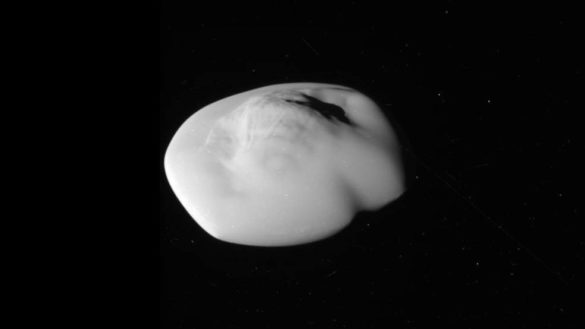

Tethys travels close to Saturn and feels the gravitational pull of the planet. Radiation from Saturn's magnetosphere could release oxygen and carbon dioxide from the icy surface. The satellite contains a faint oxygen atmosphere, about 5 trillion times less dense than the one found on Earth, but the only known oxygen atmosphere in the solar system. The second largest of the planet's major moons, Rhea is still rather small, about half the size of Earth's moon. Instead, the entire body is composed of ice, with traces of rock mixed in, causing it to resemble a dirty snowball. Rhea is a heavily cratered moon and lacks a core at its center. (Image credit: NASA/JPL/Space Science Institute) The camera was pointing toward Rhea at approximately 174,181 miles (280,317 kilometers) away. This raw image of Saturn's icy moon Rhea was taken on Maby NASA's Cassini spacecraft, and received on Earth March 10, 2013. It is possible that there is a liquid ocean beneath its surface, although scientists say that an oval-shaped core could also explain some of Mimas' libration movements. Mimas is made up primarily of water-ice, but despite its proximity to the planet (and the resulting tidal heating that should occur), the surface of the moon remains unchanged none of the ice seems to be melting, though such melting occurs on other, more distant moons. The smallest and closest orbiting of Saturn's major moons, Mimas cleared the gap known as the Cassini division between two of the planet's rings. The impact stands out despite the fact that Mimas is one of the most heavily cratered bodies in the solar system, with overlapping impacts covering the surface.
/cdn.vox-cdn.com/uploads/chorus_image/image/53616145/vrg_pan_moon_0001.0.jpg)
Mimas has a gaping crater that gives the rocky moon a strong resemblance to fictional Death Star in the "Star Wars" movies. Scientists are studying ice movements (such as landslides) to do comparative work with these types of features on Earth. The moon also contains some of the highest mountains in the solar system, which may have been material from another moon. Iapetus has a walnut-like shape, with its center bulging outward, and a ridge running around its equator. Dark hydrocarbons falling to the moon long ago, perhaps from the nearby moon Phoebe, may have had more time to absorb more heat, gradually growing and spreading over time.

Iapetus features light and dark contrasts on its surface, giving the moon a yin-yang shape. This image reveals mountains only about half that height. The equatorial ridge of Iapetus can reach heights of up to 12 miles (20 km). Impacts seem to be absorbed by the moon, and most of the ejecta is thrown into space. Hyperion has a spongy shape, possibly due to its low density and porous surface. The flattened object resembles an elongated potato rather than a sphere, a form that may have been created when an impact demolished a larger moon long ago. Hyperion is a small moon with an irregular appearance. Hyperion was the last of the major satellites to be discovered. The moon has a subsurface ocean that may be friendly to life.

The satellite's icy surface makes it one of the brightest objects in the solar system. Tidal heating causes portions of the icy planet to melt, spewing icy material into space from its "tiger stripes." The tiny bits of ice travel together to create Saturn's E ring. The moon hosts a thin oxygen atmosphereand may have a liquid ocean beneath its surface.Įnceladus contains more than 100 geysers at its south pole. Astronomers think a collision could have spun the moon on its axis. The tidally locked moon is heavily cratered not on its leading side but on its back side. (Image credit: NASA/JPL/Space Science Institute)ĭione is thought to be a dense rocky core surrounded by water-ice. Wispy terrain reflects sunlight brightly in the lower left of this Cassini image of the northern latitudes of Saturn's moon Dione.


 0 kommentar(er)
0 kommentar(er)
